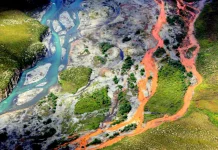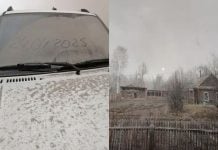
Anak Krakatoa – Indonesia
Mount Anak Krakatoa erupted again after a month without eruptions. The first eruption occurred on Thursday, December 15, at 10:31 local time.
The height of the eruption column (gray in color) reached an altitude of 700 meters above the peak and started to diffuse in the northeast direction.
The eruption was recorded on a seismograph with a maximum amplitude of 37 mm and a duration of 286 seconds.
The second eruption occurred 4 minutes later.
The ash column was observed to be white to gray in color with intensity shifting to the northeast.
Visitors and tourists are not allowed to approach the volcano within a radius of 5 km from the crater.
Indonesia is located in the Pacific Ring of Fire, a zone of high seismic and volcanic activity. There are about 130 active volcanoes in the country.
Popocatepetl volcano – Mexico
The Popocatépetl volcano registered intense activity over the weekend and into Monday morning, according to the National Coordination of Civil Protection (CNPC). The CNPC’s monitoring system, the National Center for Disaster Prevention (Cenapred), recorded 12 explosions, 3.3 hours of tremors, and 196 gas or ash emissions within a 24-hour span.
“In the last 24 hours, through the Popocatépetl volcano monitoring systems, 196 emissions were accompanied by water vapor, volcanic gas, and slight amounts of ash. Also, 199 minutes of low-amplitude and high-frequency tremors were recorded yesterday, along with 12 minor explosions,” Cenapred reported on Sunday.
Popocatépetl’s rumblings represent a Phase 2 Yellow Alert, which indicates an increase in activity and warns of light to moderate ashfall in surrounding towns, and the possibility of mudslides and pyroclastic flows (made up of lava, ash, and hot gas).
The CNPC warned nearby populations not to approach the volcano, and to be aware of the possibility of mud and debris flows in the case of heavy rain. It also requested that residents close doors and windows, avoid wearing contact lenses, cover water containers and food, and to wear a face mask in the case of respiratory illnesses due to falling ash. A population of 25 million people resides within 100 km of the volcano.
Mauna Loa and Kilauea stop erupting – Hawaii, USA
On December 13th, the alert levels of both Kilauea and Mauna Loa in Hawaii were lowered, signaling a near simultaneous end of the eruptions for both volcanoes.
This has implications for both volcanoes, as generally speaking one of the two volcanoes tends to be dominant, and when one is not erupting, the one produces more frequent eruptions.
Additionally, each volcano can cause a change at their counterpart.
Fuego eruption – Guatemala
On 11th December 2022, Guatemala’s Fuego volcano erupted releasing a huge pile of ash and smoke into the air. Fuego, which is Spanish for fire, rolled into activity overnight from 10th December into 11th, with molten rock sweeping down its slopes and ash shooting up to 2 Km into the sky.
The ash from the Fuego volcano was reportedly carried into Guatemala city, 35km away by the wind. The volcanic eruption forced Guatemalan authorities to briefly close their largest airport, The La Aurora international airport before activity eased on Sunday.














That eruption on the video had an ash cloud way above 700 Meters. And yes increased ash in the air will cool us down further, even beyond the Synthetic spray.
The volcanic activity will cool temps down. All the global warming buttclowns will have to peddle bullshit harder.